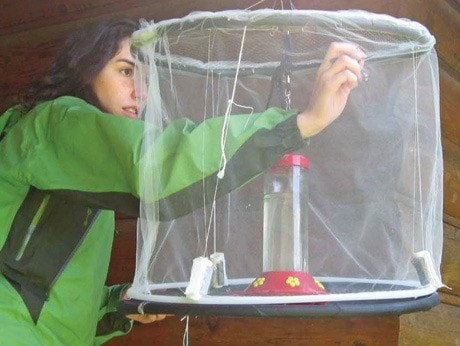The feeder is hung and the netting looms, ready to drop on the unsuspecting.
Jessica Steele holds a string, keeping a watchful eye on the trap. Once a hummingbird stops for a drink of sugar water, she’ll pull the string, causing the net to fall and trap the palm-sized bird.
It’s mid-July, but late in the season, meaning only the juveniles are still hanging around their nesting area. Mom and dad have already started their northward migration through the Rockies.
“I love the juveniles – they’re so clueless,” said Steele, a biology student at the University of Victoria. Recently, one little bird got caught in the same trap 17 times in one day.
Catching the birds, and marking them with a band in their first weeks of life, will allow the scientists who monitor them across North America to track the birds’ age as they mature.
Steele’s expedition to the Goldstream Hatchery is one of countless “banding” excursions that happen every summer.
Banders capture the birds and give them tiny numbered anklets, which serve as a unique identifier.
Unlike the Anna’s hummingbirds Victorians see year-round, the rufous are long-distance travellers. Despite weighing less than four grams, the little birds migrate every spring starting in Mexico and the Gulf states. They travel up the California coast before landing in our neck of the woods to breed. Some of the rufous travel even farther north – to Alaska – to nest.
“They follow a wave of flowering up the coast,” said head bander, Alison Moran. “Can you imagine the distances involved?”
Moran is the leader of the hummingbird project, one of many studies undertaken by the Rocky Point Bird Observatory.
Launched in 1997, the project links dozens of certified hummingbird banders in Alberta and British Columbia. Collectively, they put in thousands of unpaid hours trapping, measuring and monitoring hummingbirds. They also share information with other banding projects along the length of the birds’ migration route.
In Victoria, the rufous show up as early as late March and stay as late as mid-July.
“Hummingbirds are incredibly faithful to their route,” said Moran, who lives in Saanich. “I see the same bird at the same feeder, year after year after year, often on the same day or the same week. You can learn so much about population ecology because of this fidelity.”
This predictability can also prove to be bad news for the hummingbirds. If they’re delayed by a storm, or lose a feeding site due to development, it can throw them off course.
For these reasons, and many others, rufous populations have declined by an estimated 63 per cent in the past 40 years.
Last year, the situation worsened dramatically. The rufous simply didn’t show up as expected.
“I was waiting, waiting, waiting for them to turn up; my heart in my mouth,” Moran said.
While some banding sites reported normal numbers, other sites dropped from thousands of birds to mere tens.
Moran speculates last year’s sudden drop was due to bad weather. This year, the data has yet to be analyzed, but preliminary numbers show populations have recovered somewhat.
“We were just hugely relieved,” she said, adding, however, that the migration route is in flux.
“The southern range of the rufous may be moving northward. We’re at the southern tip of the breeding range, (so) we also may be seeing that as part of the loss.”
Christina Lam is in her third year banding hummingbirds as a certified assistant with Rocky Point Bird Observatory.
Over the summer, she has led several expeditions to the Goldstream Hatchery, Francis King Regional Park, Sooke, Salt Spring Island and other sites in the Capital Regional District.
“When I first did it, I was so scared,” said Lam, a UVic graduate who trained under Moran. “It took me about 15 minutes to band a bird – embarrassingly slow.”
Since then, she’s banded hundreds of bird, to the point where her well-practised hands now confidently manipulate the birds through the roughly two-minute procedure.
After Steele traps a bird, Lam takes over. Reaching her hand through a flap in the netting, she folds her fingers around the tiny body of the bird. It fits readily in her palm.
Once lying on its back, the bird lies totally motionless.
Lam wraps it in a tiny fabric straight jacket, fastened with a clip, which prevents it from flapping its wings. She measures the bird’s weight, the width of the legs and the length of its wings and beak. She also checks the chest feathers for parasites. Then she fits the bird with one of the 660 metal anklets she made by hand, each one inscribed with a number.
It’s jewelry for life, explains Moran.
“This is a critical project, because we are looking at a major decline and we’re trying to figure out what the heck’s going on,” she said. “What we’re trying to do is actually come up with scientific data upon which to base conservation decisions, so we’re not just waving our hands in the air.”
